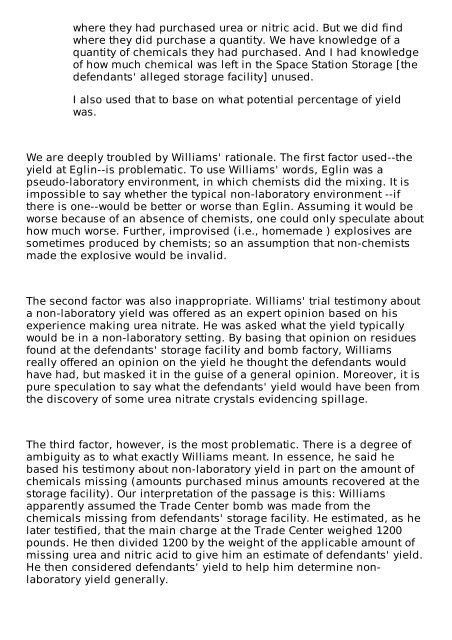linked - Investigating the Terror
linked - Investigating the Terror
linked - Investigating the Terror
You also want an ePaper? Increase the reach of your titles
YUMPU automatically turns print PDFs into web optimized ePapers that Google loves.
where <strong>the</strong>y had purchased urea or nitric acid. But we did find<br />
where <strong>the</strong>y did purchase a quantity. We have knowledge of a<br />
quantity of chemicals <strong>the</strong>y had purchased. And I had knowledge<br />
of how much chemical was left in <strong>the</strong> Space Station Storage [<strong>the</strong><br />
defendants' alleged storage facility] unused.<br />
I also used that to base on what potential percentage of yield<br />
was.<br />
We are deeply troubled by Williams' rationale. The first factor used--<strong>the</strong><br />
yield at Eglin--is problematic. To use Williams' words, Eglin was a<br />
pseudo-laboratory environment, in which chemists did <strong>the</strong> mixing. It is<br />
impossible to say whe<strong>the</strong>r <strong>the</strong> typical non-laboratory environment --if<br />
<strong>the</strong>re is one--would be better or worse than Eglin. Assuming it would be<br />
worse because of an absence of chemists, one could only speculate about<br />
how much worse. Fur<strong>the</strong>r, improvised (i.e., homemade ) explosives are<br />
sometimes produced by chemists; so an assumption that non-chemists<br />
made <strong>the</strong> explosive would be invalid.<br />
The second factor was also inappropriate. Williams' trial testimony about<br />
a non-laboratory yield was offered as an expert opinion based on his<br />
experience making urea nitrate. He was asked what <strong>the</strong> yield typically<br />
would be in a non-laboratory setting. By basing that opinion on residues<br />
found at <strong>the</strong> defendants' storage facility and bomb factory, Williams<br />
really offered an opinion on <strong>the</strong> yield he thought <strong>the</strong> defendants would<br />
have had, but masked it in <strong>the</strong> guise of a general opinion. Moreover, it is<br />
pure speculation to say what <strong>the</strong> defendants' yield would have been from<br />
<strong>the</strong> discovery of some urea nitrate crystals evidencing spillage.<br />
The third factor, however, is <strong>the</strong> most problematic. There is a degree of<br />
ambiguity as to what exactly Williams meant. In essence, he said he<br />
based his testimony about non-laboratory yield in part on <strong>the</strong> amount of<br />
chemicals missing (amounts purchased minus amounts recovered at <strong>the</strong><br />
storage facility). Our interpretation of <strong>the</strong> passage is this: Williams<br />
apparently assumed <strong>the</strong> Trade Center bomb was made from <strong>the</strong><br />
chemicals missing from defendants' storage facility. He estimated, as he<br />
later testified, that <strong>the</strong> main charge at <strong>the</strong> Trade Center weighed 1200<br />
pounds. He <strong>the</strong>n divided 1200 by <strong>the</strong> weight of <strong>the</strong> applicable amount of<br />
missing urea and nitric acid to give him an estimate of defendants' yield.<br />
He <strong>the</strong>n considered defendants' yield to help him determine nonlaboratory<br />
yield generally.


